Preparation of Microporous Polypropylene/Titanium Dioxide Composite Membranes with Enhanced Electrolyte Uptake Capability via Melt Extruding and Stretching
Abstract
:1. Introduction
2. Materials and Methods
2.1. Materials
2.2. Film and Membrane Preparation
2.3. Characterization
3. Results and Discussion
3.1. Structures of PP/TiO2 Composite Films
3.2. Deformation Behavior of PP/TiO2 Composite Films
3.3. Microstructure and Properties of the PP/TiO2 Composite Membranes
4. Conclusions
Acknowledgments
Author Contributions
Conflicts of Interest
References
- Venugopal, G.; Moore, J.; Howard, J.; Pendalwar, S. Characterization of microporous separators for lithium-ion batteries. J. Power Sources 1999, 77, 34–41. [Google Scholar] [CrossRef]
- Zhang, Z.; Arora, P. Battery separators. Chem. Rev. 2004, 104, 4419–4462. [Google Scholar]
- Zhang, S.S. A review on the separators of liquid electrolyte Li-ion batteries. J. Power Sources 2007, 164, 351–364. [Google Scholar] [CrossRef]
- Huang, X. Separator technologies for lithium-ion batteries. J. Solid State Electrochem. 2011, 15, 649–662. [Google Scholar] [CrossRef]
- Yang, M.; Hou, J. Membranes in lithium ion batteries. Membranes 2012, 2, 367–383. [Google Scholar] [CrossRef] [PubMed]
- Wang, Y.J.; Chen, C.H.; Yeh, M.L.; Hsiue, G.H. A one-side hydrophilic polypropylene membrane prepared by plasma treatment. J. Membr. Sci. 1990, 53, 275–286. [Google Scholar] [CrossRef]
- Kang, M.S.; Chun, B.; Kim, S.S. Surface modification of polypropylene membrane by low-temperature plasma treatment. J. Appl. Polym. Sci. 2001, 81, 1555–1566. [Google Scholar] [CrossRef]
- Yu, H.Y.; Hu, M.X.; Xu, Z.K.; Wang, J.L.; Wang, S.Y. Surface modification of polypropylene microporous membranes to improve their antifouling property in MBR: NH3 plasma treatment. Sep. Purif. Technol. 2005, 45, 8–15. [Google Scholar] [CrossRef]
- Dickson, J.M.; Childs, R.F.; McCarry, B.E. Development of a coating technique for the internal structure of polypropylene microfiltration membranes. J. Membr. Sci. 1998, 148, 25–36. [Google Scholar] [CrossRef]
- Zhang, C.H.; Yang, F.; Wang, W.J.; Chen, B. Preparation and characterization of hydrophilic modification of polypropylene non-woven fabric by dip-coating PVA (polyvinyl alcohol). Sep. Purif. Technol. 2008, 61, 276–286. [Google Scholar] [CrossRef]
- Xi, Z.Y.; Xu, Y.Y.; Zhu, L.P.; Wang, Y.; Zhu, B.K. A facile method of surface modification for hydrophobic polymer membranes based on the adhesive behavior of poly (DOPA) and poly (dopamine). J. Membr. Sci. 2009, 327, 244–253. [Google Scholar] [CrossRef]
- Wang, Y.; Kim, J.H.; Choo, K.H.; Lee, Y.S. Hydrophilic modification of polypropylene microfiltration membranes by ozone-induced graft polymerization. J. Membr. Sci. 2000, 169, 269–276. [Google Scholar]
- Yang, Q.; Xu, Z.K.; Dai, Z.W.; Wang, J.L.; Ulbricht, M. Surface modification of polypropylene microporous membranes with a novel glycopolymer. Chem. Mater. 2005, 17, 3050–3058. [Google Scholar] [CrossRef]
- Hu, M.X.; Yang, Q.; Xu, Z.K. Enhancing the hydrophilicity of polypropylene microporous membranes by the grafting of 2-hydroxyethyl methacrylate via a synergistic effect of photoinitiators. J. Membr. Sci. 2006, 285, 196–205. [Google Scholar] [CrossRef]
- Yang, Y.F.; Li, Y.; Li, Q.L.; Wan, L.S.; Xu, Z.K. Surface hydrophilization of microporous polypropylene membrane by grafting zwitterionic polymer for anti-biofouling. J. Membr. Sci. 2010, 362, 255–264. [Google Scholar] [CrossRef]
- Zhao, Y.H.; Wee, K.H.; Bai, R. Highly hydrophilic and low-protein-fouling polypropylene membrane prepared by surface modification with sulfobetaine-based zwitterionic polymer through a surface polymerization method. J. Membr. Sci. 2010, 362, 326–333. [Google Scholar] [CrossRef]
- Zhang, C.; Bai, Y.; Sun, Y.; Gu, J.; Xu, Y. Preparation of hydrophilic HDPE porous membranes via thermally induced phase separation by blending of amphiphilic PE-b-PEG copolymer. J. Membr. Sci. 2010, 365, 216–224. [Google Scholar] [CrossRef]
- Saffar, A.; Carreau, P.J.; Ajji, A.; Kamal, M.R. Development of polypropylene microporous hydrophilic membranes by blending with PP-g-MA and PP-g-AA. J. Membr. Sci. 2014, 462, 50–61. [Google Scholar] [CrossRef]
- Xu, M.; Shi, X.; Chen, H.; Xiao, T. Synthesis and enrichment of a macromolecular surface modifier PP-b-PVP for polypropylene. Appl. Surf. Sci. 2010, 256, 3240–3244. [Google Scholar] [CrossRef]
- Sadeghi, F.; Ajji, A.; Carreau, P.J. Study of polypropylene morphology obtained from blown and cast film processes: Initial morphology requirements for making porous membrane by stretching. J. Plast. Film Sheet 2005, 21, 199–216. [Google Scholar] [CrossRef]
- Sadeghi, F.; Ajji, A.; Carreau, P.J. Analysis of microporous membranes obtained from polypropylene films by stretching. J. Membr. Sci. 2007, 292, 62–71. [Google Scholar] [CrossRef]
- Sadeghi, F.; Ajji, A.; Carreau, P.J. Analysis of row nucleated lamellar morphology of polypropylene obtained from the cast film process: Effect of melt rheology and process conditions. Polym. Eng. Sci. 2007, 47, 1170–1178. [Google Scholar] [CrossRef]
- Tabatabaei, S.H.; Carreau, P.J.; Ajji, A. Effect of processing on the crystalline orientation, morphology, and mechanical properties of polypropylene cast films and microporous membrane formation. Polymer 2009, 50, 4228–4240. [Google Scholar] [CrossRef]
- Wang, S.; Saffar, A.; Ajji, A.; Wu, H.; Guo, S.Y. Fabrication of microporous membranes from melt extruded polypropylene precursor films via stretching: Effect of annealing. Chin. J. Polym. Sci. 2015, 33, 1028–1037. [Google Scholar] [CrossRef]
- Saffar, A.; Carreau, P.J.; Ajji, A.; Kamal, M.R. Influence of stretching on the performance of polypropylene-based microporous membranes. Ind. Eng. Chem. Res. 2014, 53, 14014–14021. [Google Scholar] [CrossRef]
- Lei, C.H.; Wu, S.Q.; Cai, Q.; Xu, R.J.; Hu, B.; Shi, W.Q. Influence of heat-setting temperature on the properties of a stretched polypropylene microporous membrane. Polym. Int. 2014, 63, 584–588. [Google Scholar]
- Park, J.S.; Gwon, S.J.; Lim, Y.M.; Nho, Y.C. Influence of the stretching temperature on an alumina filled microporous high density polyethylene membrane. Mater. Des. 2010, 31, 3215–3219. [Google Scholar] [CrossRef]
- Cai, Q.; Xu, R.; Chen, X.D.; Mo, H.B.; Lei, C.H. Structure and properties of melt-stretching polypropylene/silicon dioxide compound microporous membrane. Polym. Comps. 2015, 37, 2684–2691. [Google Scholar] [CrossRef]
- McNally, T.; Nally, G.M.; Murphy, W.R.; Cook, M. Rheology, phase morphology, mechanical, impact and thermal properties of polypropylene/metallocene catalysed ethylene 1-octene copolymer blends. Polymer 2002, 43, 3785–3795. [Google Scholar] [CrossRef]
- McInerney, L.F.; Kao, N.; Bhattacharya, S.N. Melt strength and extensibility of talc-filled polypropylene. Polym. Eng. Sci. 2003, 43, 1821–1829. [Google Scholar] [CrossRef]
- Somani, R.H.; Hsiao, B.S.; Nogales, A.; Fruitwala, H.; Srinivas, S.; Tsou, A.H. Structure development during shear flow induced crystallization of i-PP: In situ wide-angle X-ray diffraction study. Macromolecules 2001, 34, 5902–5909. [Google Scholar] [CrossRef]
- Samios, D.; Tokumoto, S.; Denardin, E.L. Large plastic deformation of isotactic poly (propylene)(iPP) evaluated by WAXD techniques. Macromol. Symp. 2005, 229, 179–187. [Google Scholar] [CrossRef]
- Mina, M.F.; Seema, S.; Matin, R.; Rahaman, M.J. Improved performance of isotactic polypropylene/titanium dioxide composites: Effect of processing conditions and filler content. Polym. Degrad. Stab. 2009, 94, 183–188. [Google Scholar] [CrossRef]
- Haese, M.D.; Puyvelde, V.P.; Langouche, F. Effect of particles on the flow-induced crystallization of polypropylene at processing speeds. Macromolecules 2010, 43, 2933–2941. [Google Scholar]
- Haese, M.D.; Langouche, F.; Puyvelde, V.P. On the Effect of Particle Size, Shape, Concentration, and Aggregation on the Flow-Induced Crystallization of Polymers. Macromolecules 2013, 46, 3425–3434. [Google Scholar]
- Samuels, R.J. High strength elastic polypropylene. J. Polym. Sci. Part B Polym. Phys. 2003, 17, 535–568. [Google Scholar] [CrossRef]
- Gong, L.; Wool, R.P. Adhesion at polymer-solid interfaces: Influence of sticker groups on structure, chain connectivity and strength. J. Adhes. 1999, 71, 189–209. [Google Scholar] [CrossRef]
- Etelaaho, P.; Haveri, S.; Jarvela, P. Comparison of the morphology and mechanical properties of unmodified and surface-modified nanosized calcium carbonate in a polypropylene matrix. Polym. Compos. 2011, 32, 464–471. [Google Scholar] [CrossRef]
- Sudar, A.; Moczo, J.; Voros, G.; Pukanszky, B. The mechanism and kinetics of void formation and growth in particulate filled PE composites. Express Polym. Lett. 2007, 1, 763–772. [Google Scholar] [CrossRef]
- Saffar, A.; Carreau, P.J.; Kamal, M.R.; Ajji, A. Hydrophilic modification of polypropylene microporous membranes by grafting TiO2 nanoparticles with acrylic acid groups on the surface. Polymer 2014, 55, 6069–6075. [Google Scholar] [CrossRef]
- Fu, S.Y.; Feng, X.Q.; Lauke, B.; Mai, Y.W. Effects of particle size, particle/matrix interface adhesion and particle loading on mechanical properties of particulate–polymer composites. Compos. Part B Eng. 2008, 39, 933–961. [Google Scholar] [CrossRef]
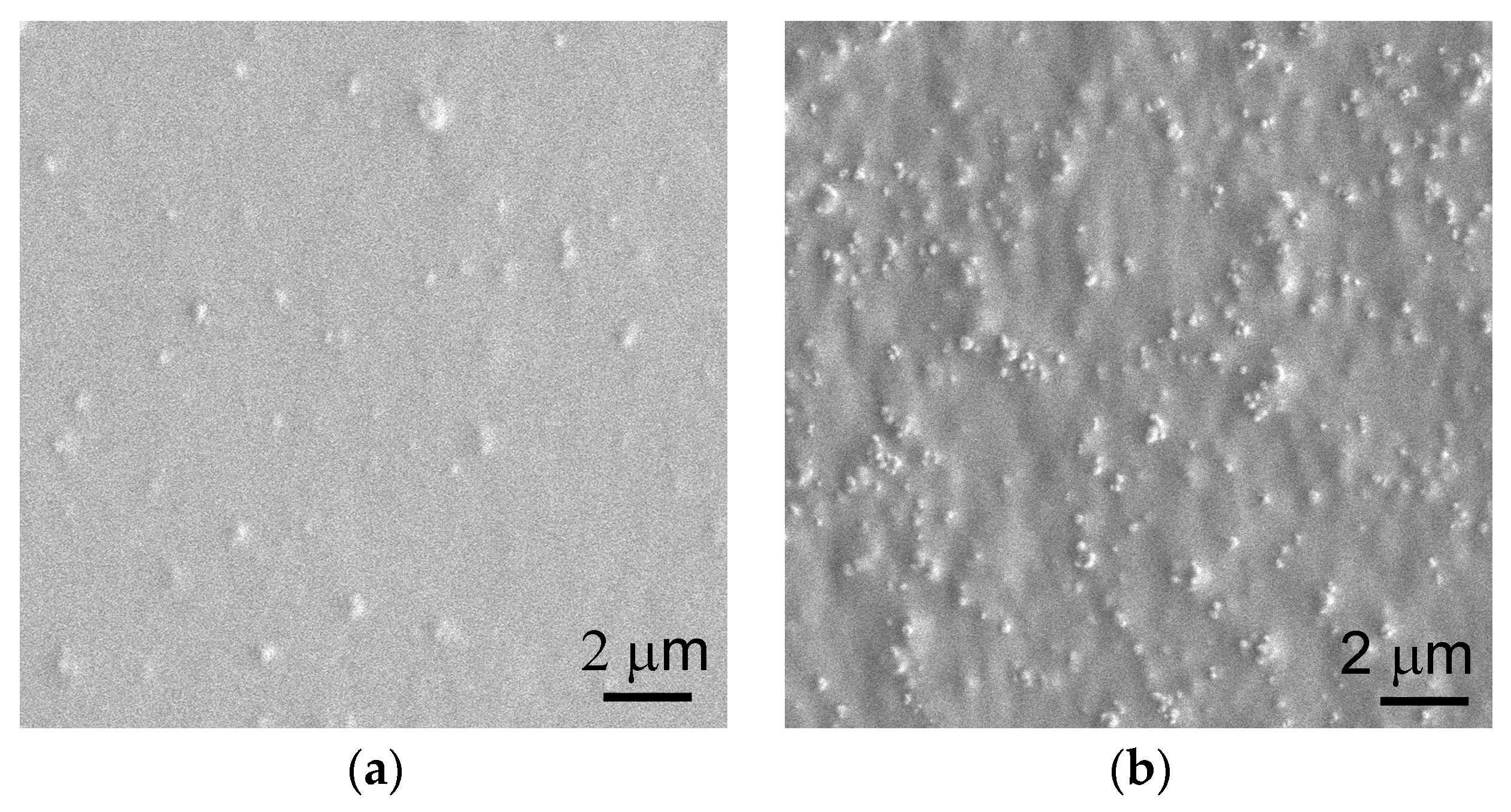
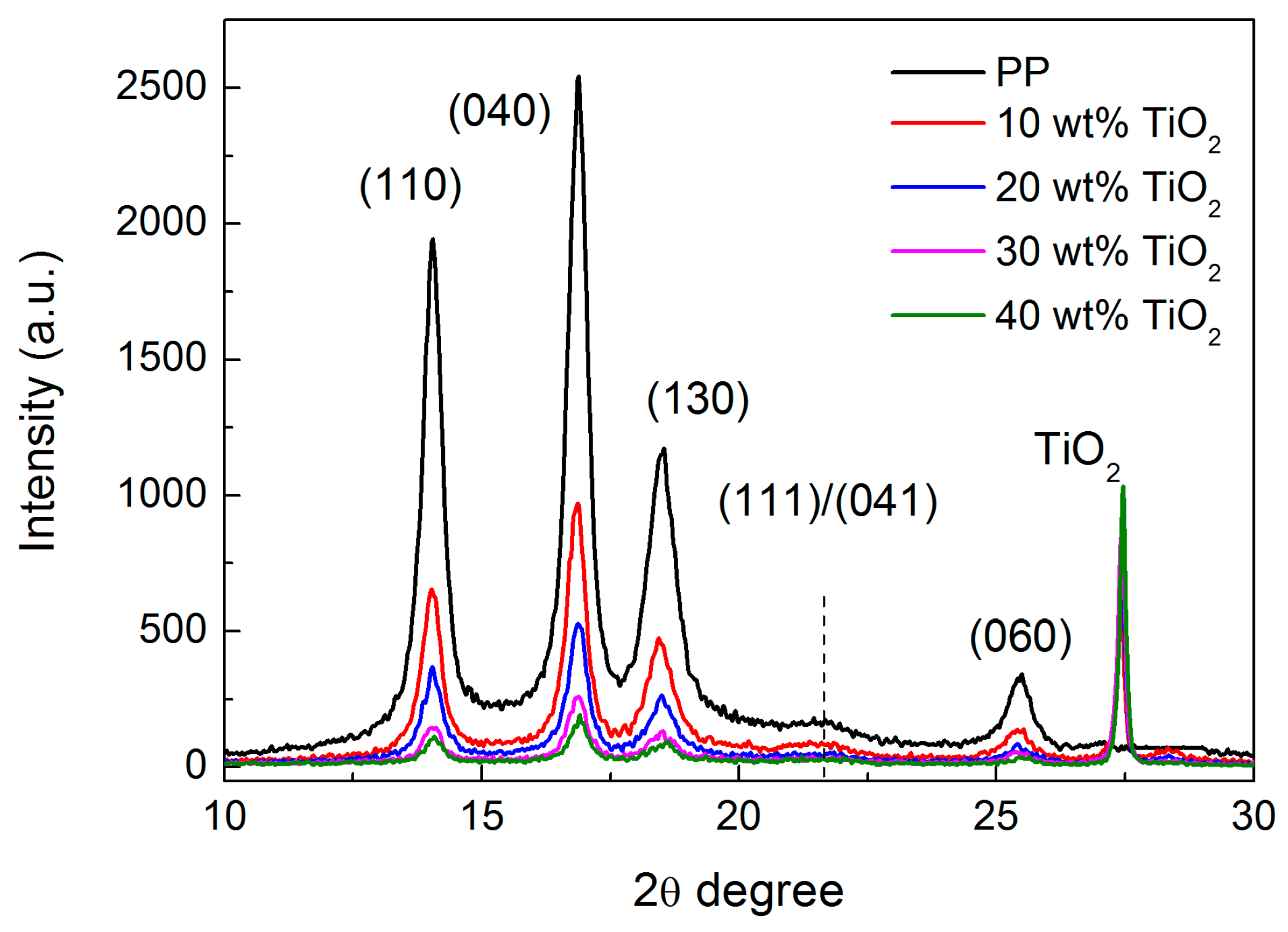
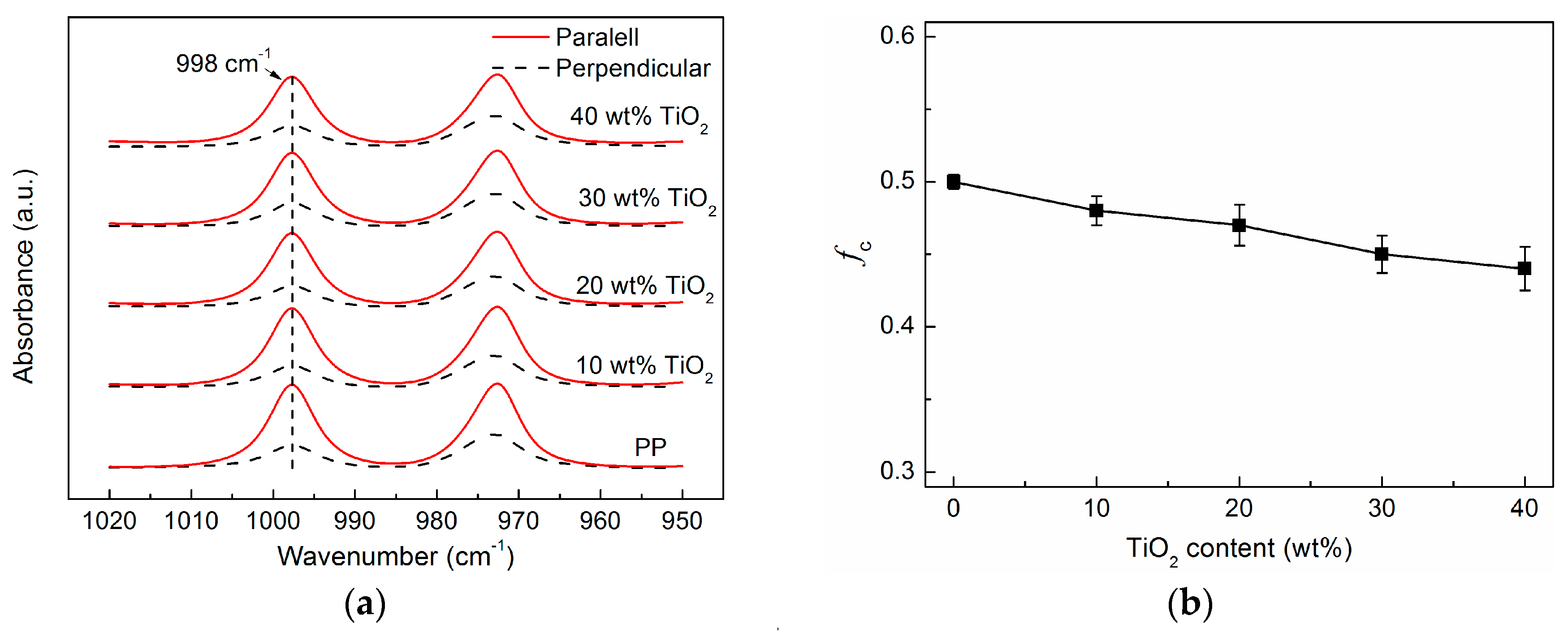

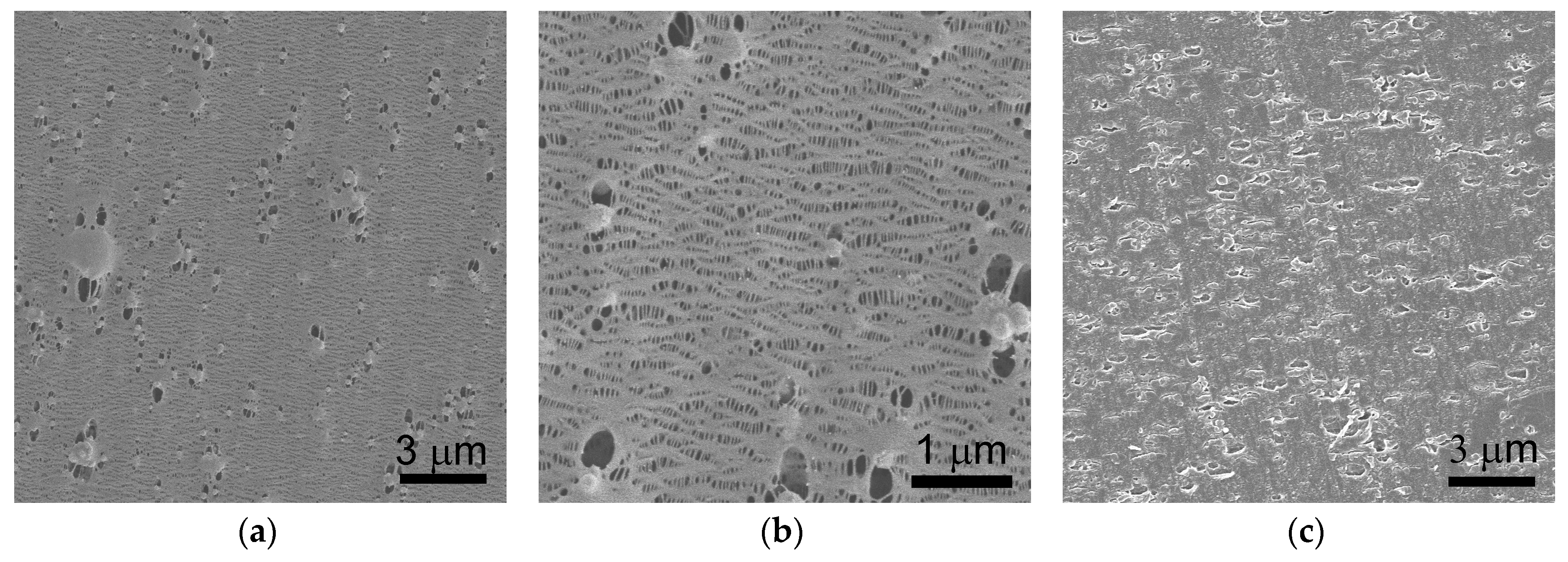
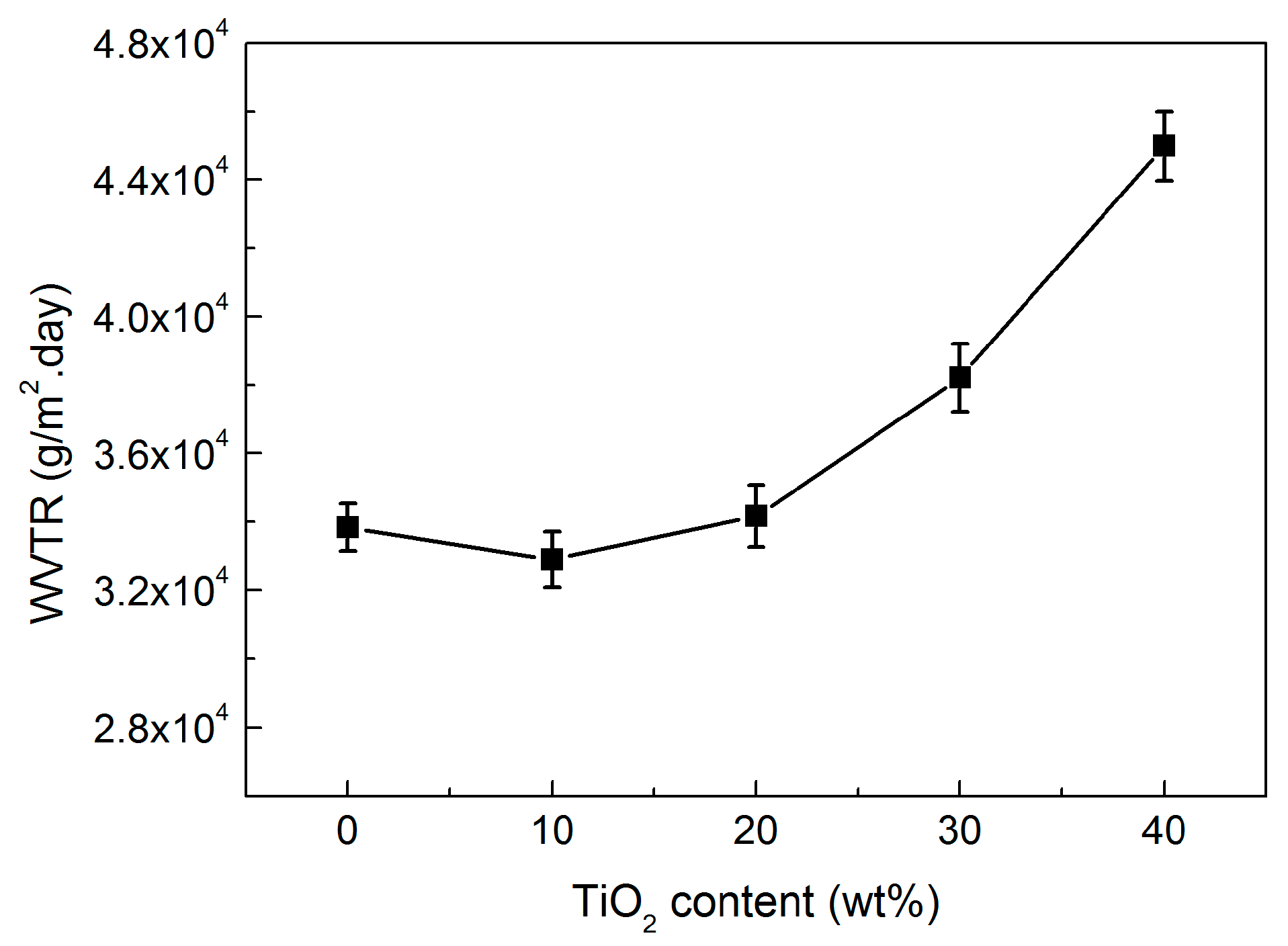


| TiO2 content (wt %) | Tm (°C) | Xc % |
|---|---|---|
| 0 | 164.4 | 41.8 |
| 10 | 164.1 | 41.5 |
| 20 | 164.8 | 42.0 |
| 30 | 163.9 | 42.1 |
| 40 | 164.2 | 41.6 |
| TiO2 content (wt %) | Tensile strength (MPa) | Elongation at break (%) |
|---|---|---|
| 0 | 118.4 | 92.7 |
| 10 | 115.5 | 88.3 |
| 20 | 112.8 | 85.6 |
| 30 | 108.3 | 86.4 |
| 40 | 104.6 | 84.5 |
© 2017 by the authors. Licensee MDPI, Basel, Switzerland. This article is an open access article distributed under the terms and conditions of the Creative Commons Attribution (CC BY) license ( http://creativecommons.org/licenses/by/4.0/).
Share and Cite
Wang, S.; Ajji, A.; Guo, S.; Xiong, C. Preparation of Microporous Polypropylene/Titanium Dioxide Composite Membranes with Enhanced Electrolyte Uptake Capability via Melt Extruding and Stretching. Polymers 2017, 9, 110. https://doi.org/10.3390/polym9030110
Wang S, Ajji A, Guo S, Xiong C. Preparation of Microporous Polypropylene/Titanium Dioxide Composite Membranes with Enhanced Electrolyte Uptake Capability via Melt Extruding and Stretching. Polymers. 2017; 9(3):110. https://doi.org/10.3390/polym9030110
Chicago/Turabian StyleWang, Shan, Abdellah Ajji, Shaoyun Guo, and Chuanxi Xiong. 2017. "Preparation of Microporous Polypropylene/Titanium Dioxide Composite Membranes with Enhanced Electrolyte Uptake Capability via Melt Extruding and Stretching" Polymers 9, no. 3: 110. https://doi.org/10.3390/polym9030110





